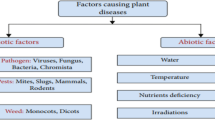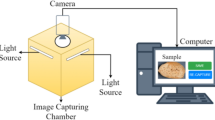Abstract
In recent years, there have been significant achievements in object classification with various techniques using several deep learning architectures. These architectures are now also used for classification and detection of many plant diseases. Olives are important plant species which are grown in certain regions of the world. The disease types that affect the olive plants vary on the region where it is grown. This study presents a data set consisting of 3400 olive leaves samples which also includes healthy leaves so as to detect Aculus olearius and Olive peacock spot diseases, which are common olive plant diseases in Turkey. This experimental study used transfer learning methods on VGG16 and VGG19 architectures, as well as on our proposed CNN architecture. Effects of data augmentation on performance were one aim of this research. In the experimental studies which applied data augmentation the highest success value in trained models was 95%, whereas in the experiments without data augmentation the highest value was 88%. Another subject of this research is the Adam, AdaGrad, Stochastic gradient descent and RMS Prop optimization algorithms’ effect on the network’s performance. As a result of the conducted experiments, Adam and SGD optimization algorithms were generally observed to generate superior results.









Similar content being viewed by others
Code availability
Not applicable.
References
United Nations DoE, Social Affairs PD (2019) World population prospects 2019: highlights
Odegard I, Van der Voet E (2014) The future of food—scenarios and the effect on natural resource use in agriculture in 2050. Ecol Econ 97:51–59
Gregory PJ, Johnson SN, Newton AC, Ingram JS (2009) Integrating pests and pathogens into the climate change/food security debate. J Exp Bot 60(10):2827–2838
Mohanty SP, Hughes DP, Salathé M (2016) Using deep learning for image-based plant disease detection. Front Plant Sci 7:1419
Dong H, Zhang X, Choen Y, Zhou Y, Li W, Li Z (2006) Dry mycelium of Penicillium chrysogenum protects cotton plants against wilt diseases and increases yield under field conditions. Crop Prot 25(4):324–330
Braunack M, Garside A, Magarey R (2012) Reduced tillage planting and the long-term effect on soil-borne disease and yield of sugarcane (Saccharum inter-specific hybrid) in Queensland, Australia. Soil Tillage Res 120:85–91
Kaur S, Pandey S, Goel S (2019) Plants disease identification and classification through leaf images: a survey. Arch Comput Methods Eng 26(2):507–530
Council IO (2018) World oil production. https://www.internationaloliveoil.org/what-we-do/economic-affairs-promotion-unit/. Accessed 13 Dec 2019
Zeytin ve Zeytin Yağı Raporu (2018). T.C. Gümrük ve Ticaret Bakanlığı Kooperatifçilik Genel Müdürlüğü
Çetin H, Alaoglu O (2006) Mut (Mersin) ilcesindeki zeytin agaclarnda bulunan eriophyid akar turleri ve zarar sekilleri. Turk Entomol Derg 30(4):303–315
Obanor FO, Jaspers MV, Jones EE, Walter M (2008) Greenhouse and field evaluation of fungicides for control of olive leaf spot in New Zealand. Crop Prot 27(10):1335–1342
Ashqar BA, Abu-Naser SS (2018) Image-based tomato leaves diseases detection using deep learning. Int J Acad Eng Res 2(12):10–16
Adeel A, Khan MA, Sharif M, Azam F, Shah JH, Umer T, Wan S (2019) Diagnosis and recognition of grape leaf diseases: an automated system based on a novel saliency approach and canonical correlation analysis based multiple features fusion. Sustain Comput Inform Syst 24:100349
Al-Tarawneh MS (2013) An empirical investigation of olive leave spot disease using auto-crop** segmentation and fuzzy C-means classification. World Appl Sci J 23(9):1207–1211
Ashourloo D, Aghighi H, Matkan AA, Mobasheri MR, Rad AM (2016) An investigation into machine learning regression techniques for the leaf rust disease detection using hyperspectral measurement. IEEE J Sel Top Appl Earth Observ Remote Sens 9(9):4344–4351
Lisu C, Yuanyuan S, Ke W (2017) Rapid diagnosis of nitrogen nutrition status in rice based on static scanning and extraction of leaf and sheath characteristics. Int J Agric Biol Eng 10(3):158–164
Asraf HM, Nooritawati M, Rizam MS (2012) A comparative study in kernel-based support vector machine of oil palm leaves nutrient disease. Proc Eng 41:1353–1359
Borhan M, Panigrahi S, Satter M, Gu H (2017) Evaluation of computer imaging technique for predicting the SPAD readings in potato leaves. Inform Process Agric 4(4):275–282
Ji-Yong S, **ao-Bo Z, Jie-Wen Z, Kai-Liang W, Zheng-Wei C, **ao-Wei H, De-Tao Z, Holmes M (2012) Nondestructive diagnostics of nitrogen deficiency by cucumber leaf chlorophyll distribution map based on near infrared hyperspectral imaging. Sci Hortic 138:190–197
Selvaraj MG, Vergara A, Ruiz H, Safari N, Elayabalan S, Ocimati W, Blomme G (2019) AI-powered banana diseases and pest detection. Plant Methods 15(1):92
Zhang K, Xu Z, Dong S, Cen C, Wu Q (2019) Identification of peach leaf disease infected by Xanthomonas campestris with deep learning. Eng Agric Environ Food 12(4):388–396
Priyadharshini RA, Arivazhagan S, Arun M, Mirnalini A (2019) Maize leaf disease classification using deep convolutional neural networks. Neural Comput Appl 31(12):8887–8895
Ji M, Zhang L, Wu Q (2019) Automatic grape leaf diseases identification via UnitedModel based on multiple convolutional neural networks. Inf Process Agric. https://doi.org/10.1016/j.inpa.2019.10.003
Wallelign S, Polceanu M, Buche C (2018) Soybean plant disease ıdentification using convolutional neural network. In: The thirty-first ınternational flairs conference, 2018
Fuentes A, Yoon S, Kim S, Park D (2017) A robust deep-learning-based detector for real-time tomato plant diseases and pests recognition. Sensors 17(9):2022
Lu J, Hu J, Zhao G, Mei F, Zhang C (2017) An in-field automatic wheat disease diagnosis system. Comput Electron Agric 142:369–379
Liu B, Zhang Y, He D, Li Y (2018) Identification of apple leaf diseases based on deep convolutional neural networks. Symmetry 10(1):11
Hu G, Yang X, Zhang Y, Wan M (2019) Identification of tea leaf diseases by using an improved deep convolutional neural network. Sustain Comput Info Syst 24:100353
Barbedo JGA (2019) Plant disease identification from individual lesions and spots using deep learning. Biosys Eng 180:96–107
Geetharamani G, Pandian A (2019) Identification of plant leaf diseases using a nine-layer deep convolutional neural network. Comput Electr Eng 76:323–338
Too EC, Yujian L, Njuki S, Yingchun L (2019) A comparative study of fine-tuning deep learning models for plant disease identification. Comput Electron Agric 161:272–279
Ferentinos KP (2018) Deep learning models for plant disease detection and diagnosis. Comput Electron Agric 145:311–318
Alruwaili M, Alanazi S, El-Ghany SA, Shehab A (2019) An efficient deep learning model for olive diseases detection. Int J Adv Comput Sci Appl 10(8):486–492
Cruz AC, Luvisi A, De Bellis L, Ampatzidis Y (2017) X-FIDO: an effective application for detecting olive quick decline syndrome with deep learning and data fusion. Front Plant Sci 8:1741
LeCun Y, Bottou L, Bengio Y, Haffner P (1998) Gradient-based learning applied to document recognition. Proc IEEE 86(11):2278–2324
Krizhevsky A, Sutskever I, Hinton GE (2012) Imagenet classification with deep convolutional neural networks. In: Advances in neural information processing systems, 2012. pp 1097–1105
Uğuz S (2019) Makine öğrenmesi-Teorik yönleri ve Python uygulamaları ile bir yapay zeka ekolü. Nobel Academic Publish, Turkey (in Turkish)
Wong SC, Gatt A, Stamatescu V, McDonnell MD (2016) Understanding data augmentation for classification: when to warp? In: 2016 international conference on digital image computing: techniques and applications (DICTA), 2016. IEEE, pp 1–6
Chollet F (2015) Keras. https://github.com/fchollet/keras
Kamilaris A, Prenafeta-Boldú FX (2018) Deep learning in agriculture: a survey. Comput Electron Agric 147:70–90
Simonyan K, Zisserman A (2014) Very deep convolutional networks for large-scale image recognition. ar**v preprint ar**v:14091556
Ioffe S, Szegedy C (2015) Batch normalization: accelerating deep network training by reducing internal covariate shift. ar**v preprint ar**v:150203167
Khan S, Rahmani H, Shah SAA, Bennamoun M (2018) A guide to convolutional neural networks for computer vision. Synth Lect Comput Vis 8(1):1–207
Srivastava N, Hinton G, Krizhevsky A, Sutskever I, Salakhutdinov R (2014) Dropout: a simple way to prevent neural networks from overfitting. J Mach Learn Res 15(1):1929–1958
Francis M, Deisy C (2019) Disease detection and classification in agricultural plants using convolutional neural networks—a visual understanding. In: 2019 6th ınternational conference on signal processing and ıntegrated networks (SPIN). IEEE, pp 1063–1068
Subramanian V (2018) Deep learning with PyTorch: a practical approach to building neural network models using PyTorch. Packt Publishing Ltd, Birmingham
Vasilev I, Slater D, Spacagna G, Roelants P, Zocca V (2019) Python deep learning: exploring deep learning techniques and neural network architectures with PyTorch, Keras, and TensorFlow. Pack Publishing, Birmingham
Kaya A, Keceli AS, Catal C, Yalic HY, Temucin H, Tekinerdogan B (2019) Analysis of transfer learning for deep neural network based plant classification models. Comput Electron Agric 158:20–29
Funding
The author(s) received no financial support for the research, authorship, and/or publication of this article.
Author information
Authors and Affiliations
Contributions
All authors contributed to the study conception and design. Material preparation, data collection and analysis were performed by NU. The first draft of the manuscript was written by SU. The authors read and approved the final manuscript.
Corresponding author
Ethics declarations
Conflict of interest
The authors declare that they have no conflict of interest.
Availability of data and material
Not applicable.
Additional information
Publisher's Note
Springer Nature remains neutral with regard to jurisdictional claims in published maps and institutional affiliations.
Rights and permissions
About this article
Cite this article
Uğuz, S., Uysal, N. Classification of olive leaf diseases using deep convolutional neural networks. Neural Comput & Applic 33, 4133–4149 (2021). https://doi.org/10.1007/s00521-020-05235-5
Received:
Accepted:
Published:
Issue Date:
DOI: https://doi.org/10.1007/s00521-020-05235-5




